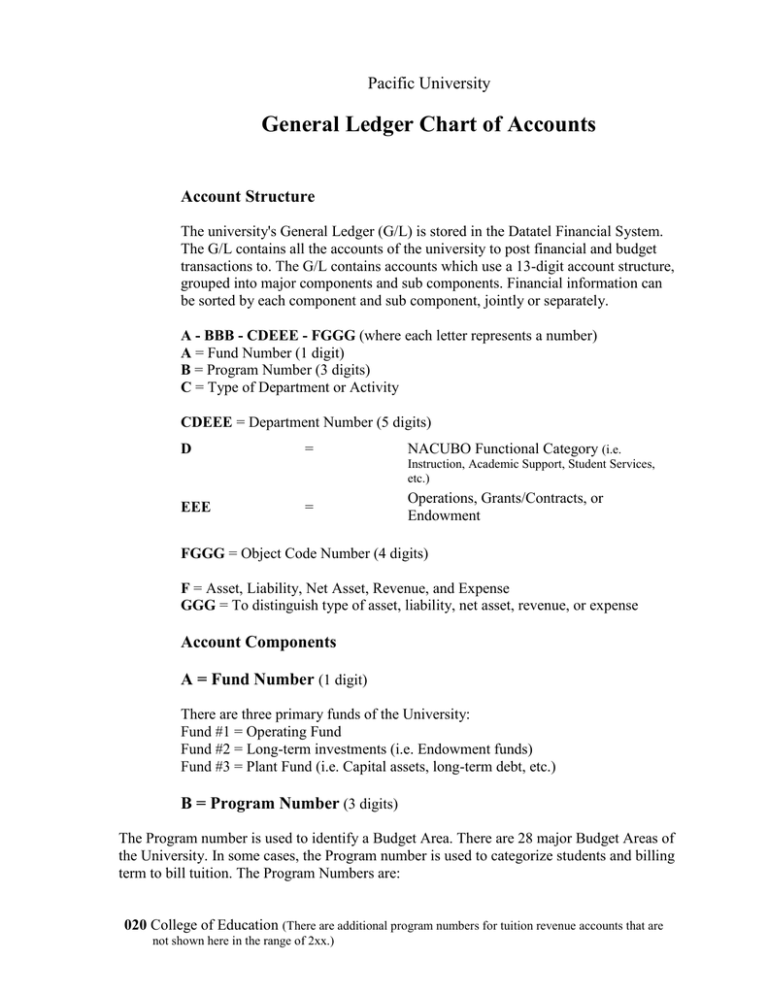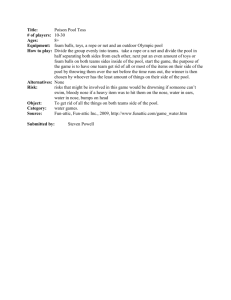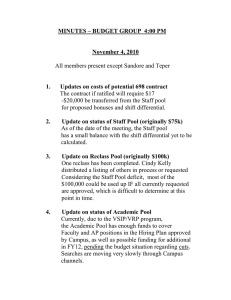General Ledger Chart of Accounts Pacific University Account Structure
advertisement

Pacific University General Ledger Chart of Accounts Account Structure The university's General Ledger (G/L) is stored in the Datatel Financial System. The G/L contains all the accounts of the university to post financial and budget transactions to. The G/L contains accounts which use a 13-digit account structure, grouped into major components and sub components. Financial information can be sorted by each component and sub component, jointly or separately. A - BBB - CDEEE - FGGG (where each letter represents a number) A = Fund Number (1 digit) B = Program Number (3 digits) C = Type of Department or Activity CDEEE = Department Number (5 digits) D = NACUBO Functional Category (i.e. Instruction, Academic Support, Student Services, etc.) EEE = Operations, Grants/Contracts, or Endowment FGGG = Object Code Number (4 digits) F = Asset, Liability, Net Asset, Revenue, and Expense GGG = To distinguish type of asset, liability, net asset, revenue, or expense Account Components A = Fund Number (1 digit) There are three primary funds of the University: Fund #1 = Operating Fund Fund #2 = Long-term investments (i.e. Endowment funds) Fund #3 = Plant Fund (i.e. Capital assets, long-term debt, etc.) B = Program Number (3 digits) The Program number is used to identify a Budget Area. There are 28 major Budget Areas of the University. In some cases, the Program number is used to categorize students and billing term to bill tuition. The Program Numbers are: 020 College of Education (There are additional program numbers for tuition revenue accounts that are not shown here in the range of 2xx.) 030 School of Occupational Therapy 040 College of Optometry 050 School of Physical Therapy 060 School of Professional Psychology 080 School of Physician Assistant Studies 30x College of Arts & Sciences Administration (There are additional program numbers for tuition revenue accounts that are not shown here in the range of 3xx.) 300 Travel Classes 310 Dean, Research, Tutoring Center 311 Advising, Career Development 320 School of Arts & Humanities 330 School of Natural Sciences 340 School of Social Sciences 370 Masters of Fine Arts 500 College of Health Professions & Continuing Education 510 School of Dental Health Science 520 School of Pharmacy 550 Masters of Healthcare Administration 551 Health Science 560 Gerontology 580 Audiology 80x Auxiliary Enterprises 800 Auxiliary Enterprises Office 801 Bookstore 802 Food Service 804 Housing Operations 805 Residence Halls 900 President’s Office 91x Student Affairs 910 Student Services Administration 912 Health/Counseling Services 913 Learning Support Services 914 Wellness & Res Life 915 Student Activities 916 Admissions 918 Orientation & Parent Support 919 PIC 93x University Information Services 930 Chief Information Officer 932 Health Professions Information Systems 94x Academic Affairs 940 Academic Affairs Office, International Programs, ELI, Diversity, Inst. Research, Sustainability 944 Registrar 946 Athletics 950 Library 96x Finance and Administration 960 Finance & Administration Office (includes Legal Affairs) 962 Business Office 963 Human Resources 965 Facilities 966 Financial Aid 97x Central Operations 970 Central Operations (General and Leases) 972 Benefits 976 Central Facilities 98x University Relations 980 University Advancement Office 981 Development 982 Advancement Services 983 Alumni Relations 984 Marketing and Communications 985 Conference and Event Support Services CDEEE = Department Number (5 digits) The Department Number contains the name of a department or it can also be the name of a restricted grant or activity. Some examples of Department names are Business Office, Registrar, Health Services, Arts & Sci Administration, and Physical Therapy Instruction. Some other Department Names are Baseball Camp, XYZ Grant, and ABC Endowment. C = Type of Department or Activity 0 = Regular Operations 1 = Auxiliary activity 2 = Agency activity 3 = Independent activity ("IA" code when setting up account) D = Functional classification of the department The second digit of the 5-digit number denotes the functional classification of the department name. For example: 1 = Instruction 2 = Research 3 = Public Service 4 = Academic Support 5 = Clinics 6 = Student Services 7 = Institutional Support 8 = Plant Operation/Maintenance 9 = Scholarships EEE = Operations, Grant/Contract, or Endowment 000 - 199 = Operations--Board approved budget 200 - 299 = Operations--non-Board budget 300 - 599 = Grant or Contract 600 - 999 = Endowment Some examples of Department Names are: 01033 Physical Therapy Instruction 05001 Clinic Administration 07030 Business Office 06147 Baseball Camp 02321 XYZ Grant 07645 ABC Endowment FGGG = Object Code Number Object Code Number distinguishes type of an account or transaction (receipt or expenditure). There are many types of Object Code Numbers. F = Asset, Liability, Net Asset, Revenue, and Expense 1 = Asset 2 = Liability 3 = Net Assets 4 = Revenue 5 = Revenue-temporarily restricted 6 = Revenue-permanently restricted 7 = Expense GGG = Distinguishes type of Asset, Liability, Net Asset, Revenue, or Expense Revenues are grouped by Object Code into 11 main groups. They are: 4001; 4016; 4018; 4020 - 4069 Tuition 47xx Tuition discounts 4002 - 4015; 4017; 4019; 4070 - 4099 Fees 41xx Unrestricted contributions 42xx Contracts/Exchanges 4301 Investment income--endowment restricted 4302 - 4303 Other investment income 4402; 4404 Net realized gains (losses) on other investments 45xx Sales of services of clinics 46xx Sales of services of auxiliary enterprises 48xx Other Expenses are grouped by Object Code into 4 main groups-Payroll, Other, Budget Pool, and Capital/Transfers. The Object Code Ranges are: 7000 7099 Payroll 7100 7199 N/A-used for another purpose 7200 7429 Poolee (grouped with Budget Pool) 7430 7599 Other 7600 7699 Budget Pool (#7601 is departmental Budget Pool #) 7700 7799 Capital and Transfers 7800 7899 Extraordinary Items (grouped with Other; seldom used) 7900 7939 Designation of Funds (grouped with Other; seldom used) 7940 7999 Benefits (grouped with Other) Some examples of Object Codes are: 4001 Tuition 4501 Sales and Services of Clinics 5213 Contributions-temporarily restricted 7601 Budget Pool 7001 FT Faculty Salary 7201 Supplies-office 7448 Contractual Services 7707 Capital Equipment - items > $1,000 or more per item Payroll Object Codes The following is a list of the primary payroll object codes used to pay employees, plus a short description for some object codes identifying their use. It is important to use the correct codes. Payroll requests received with the incorrect codes will be changed to the proper code and the department will be notified. 7001 Full-time Faculty Salaries (Monthly, Salary employees) 7002 Full-time Administration Salaries (Monthly, Salary employees) 7003 Full-time Staff Wages (Semimonthly, Hourly employees) 7004 Part-time Faculty Salaries (Faculty which are not full-time or benefit eligible for Pacific Univ.) 7005 Part-time Administration Salaries 7006 Part-time Staff Wages 7007 Staff Overtime 7009 Additional Payments (Payment in addition to a contract or agreement) Example: If a faculty member is full-time on campus, but not in your department, use this object to you would pay him/her in any additional amounts to his/her regular contract 7010 Resident Assistant 7011 Interns 7012 Short-term Disability Salary 7014 Music Lesson Instructor 7015 Coach Salary 7020 Student Wages - FWS 7021 Student Wages - PWS (RSE) 7022 Student Wages - Department 7023 Student Stipends - Department 7032 Moving/Relocation Compensation 7034 Sabbaticals 7035 Uniform Allowance 7036 Temporary Employment 7037 Independent Contractors 7090 Fringes If you have any question on which object code to use, please contact the Payroll department in Human Resources. Budget Pool and Poolee Accounts A Budget Pool account is expense object codes linked to a single budget account number (umbrella account number A-BBB-CCDDD-7601). The Pool account is used primarily to determine funds availability. The Budget Pool account, with object code 7601, contains only budget transactions. The Budget Pool account should not be used for actual financial transactions. The accounts linked to the Budget Pool account are called Poolee accounts. Poolee accounts should only have actual financial transactions. The Poolee accounts should not have any budget transactions. Funds availability is determined by summing all the Poolee amounts and comparing the total against the associated Budget Pool account. If the net amount is positive, the positive net amount is budget funds available. If the net amount is negative, then there is a budget shortfall (overage) and you need to make a Budget Transfer into the related Budget Pool account to cover the shortfall There are some advantages and disadvantages in using the Budget Pool method. The advantages are not having to budget through Datatel every single account (Poolee accounts) and not having to submit multiple budget adjustments throughout the year to cover overages. A disadvantage is not being able to track specific expense Poolee accounts against your estimates. Another disadvantage is that once an account is set up as a Poolee account, it is sometimes impossible to unpool the account because of a Datatel glitch in the system. Generally, Poolee accounts are those with few to many small dollar transactions. Some examples of Poolee object codes are: 7201 Supplies-office 7209 Minor equipment 7402 Postage 7404 Telephone/fax 7411 Photocopy/outside At Pacific, only the Poolee range is pooled. Again, the Poolee range is 7200 7429. No other object codes are pooled. This page is maintained by the Budget Office





